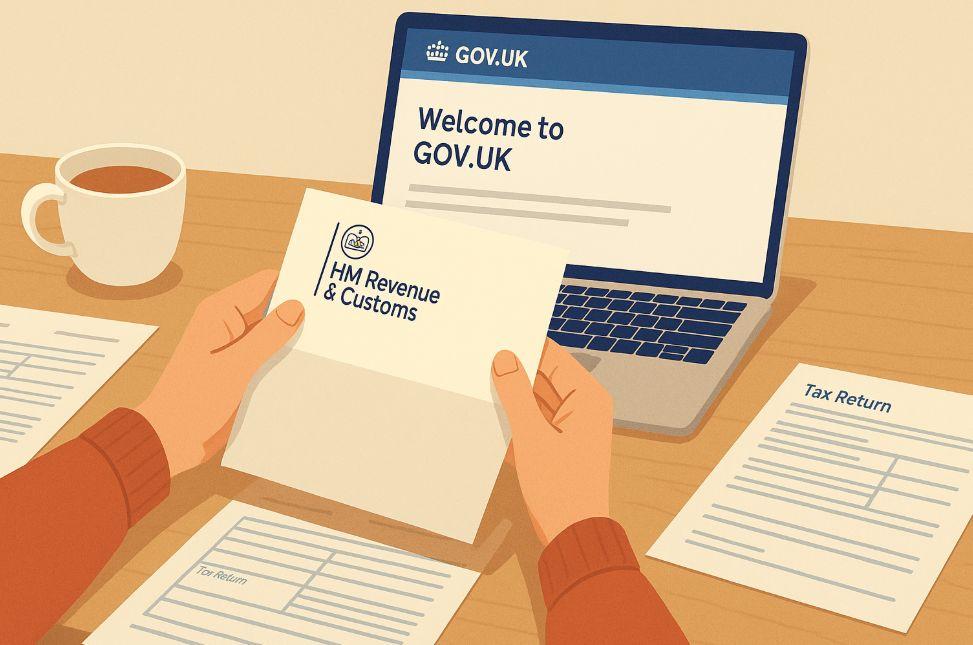In 2025, more UK taxpayers than ever are receiving HMRC tax savings letters notices that could signal a surprise refund or adjustment in your tax situation. Whether you’re a full-time employee, a pensioner, or a freelancer, these letters could mean HMRC owes you money without you even knowing it.
But how do you identify a legitimate letter, understand what it means, and most importantly claim what you’re owed?
Let’s explore everything you need to know about HMRC tax savings letters, including eligibility, claiming methods, common pitfalls, and future-proofing your tax records.
What Are HMRC Tax Savings Letters and Why Are They Sent?

The Purpose Behind Tax Savings Letters
Each year, HMRC conducts reconciliations to ensure taxpayers have paid the correct amount based on income and deductions. When discrepancies are discovered such as overpaid or underpaid income tax HMRC issues letters to notify the taxpayer.
These letters are typically triggered when tax records don’t align with reported employment, pension, or benefits data. In cases where you’ve overpaid, HMRC may issue a P800 letter, inviting you to claim a refund.
Common Triggers for a Refund Letter
Overpayments may happen for various reasons, often without the taxpayer’s awareness. You might have changed jobs mid-year, been on an emergency tax code, or had multiple income sources not properly balanced. HMRC captures this data and reconciles it at the end of the tax year to issue any corrections.
Who Is Eligible to Receive a Tax Refund from HMRC?
PAYE Workers and Tax Overpayments
If you’re taxed under the Pay As You Earn (PAYE) system, you may be eligible for a refund if your employer deducted too much tax from your salary. This is common among workers who have:
- Switched jobs
- Started or stopped working partway through the year
- Been placed on a temporary or emergency tax code
Each of these situations could lead to an excess amount being paid to HMRC, and their system flags such scenarios for correction.
Self-Assessment Filers and Refund Opportunities
Those filing annual Self-Assessment tax returns are also entitled to refunds under certain conditions. If you’ve over-reported your income or underestimated allowable expenses, your tax bill may be recalculated and reduced. In such cases, HMRC typically processes the overpayment through direct bank transfer or adjustment in the following year’s return.
How Can You Tell If Your HMRC Letter Is Genuine?
Recognising a Legitimate Letter
A genuine HMRC tax savings letter will be printed on official stationery and include your full name, National Insurance number or Unique Taxpayer Reference (UTR), and a clear explanation of why you’re being contacted. It will also direct you to gov.uk for further action.
Avoiding Tax Refund Scams
Unfortunately, fraudsters often impersonate HMRC through fake emails, texts, or letters. Scams typically urge immediate action, demand personal bank details, or threaten penalties. Real HMRC correspondence will never ask for your full bank details by email or text.
To verify authenticity, compare the contact information in the letter with what’s listed on the official GOV.UK website or call HMRC’s verified helpline directly.
How Do You Claim a Tax Refund from HMRC in 2025?

Using the HMRC Personal Tax Account
If you receive a P800 letter stating you’re due a refund, you can claim it by logging into your Personal Tax Account on the GOV.UK website. You’ll need your Government Gateway login credentials and National Insurance number to access your account securely.
Once logged in, you’ll be guided through a simple process to review the refund amount and input your bank details for direct payment.
Claiming via Post
For those who prefer or require offline options, you can claim your tax refund by completing and submitting form R40. This should be sent to HMRC along with relevant supporting documents like P60s or payslips. Although this method is slower, it remains a valid and reliable approach.
Comparing Claim Methods
| Claim Method | Timeframe | Tools Needed | Ideal For |
| Online via Account | 5–10 working days | Government Gateway, NI Number | Most individuals with internet access |
| Postal (Form R40) | 3–6 weeks | Paper forms, income documents | Individuals without online access |
What Documents Do You Need to Claim Your Tax Back?
Essential Income Records
To process your refund accurately, HMRC requires proof of your income and taxes paid. The most common documents include your:
- P60 (end-of-year income summary)
- P45 (if you left a job mid-year)
- Payslips for regular income verification
These help HMRC validate any overpayments or errors in your tax record.
Replacing Lost Documents
If you can’t locate these documents, contact your employer or pension provider to issue duplicates. Additionally, many records are now stored digitally in your HMRC Personal Tax Account, where you can download them directly.
How Long Does It Take to Get a Tax Refund from HMRC?
Processing Timeframes
HMRC typically processes online refund claims within 5 to 10 working days, making it the most efficient method. Postal claims, on the other hand, may take up to six weeks, especially during busy periods like April to July.
Managing Delays
Delays may occur if:
- The bank details provided are incorrect
- Your identity requires further verification
- Additional documents are requested
If your refund hasn’t arrived after two weeks (online) or six weeks (postal), contact HMRC for a status update.
What Are the Common Mistakes to Avoid When Claiming a Refund?

Entering Incorrect Information
Providing incorrect account details or forgetting to include vital identifiers like your National Insurance number can delay or prevent your refund. Always double-check your entries before submitting your claim.
Missing Deadlines
Refund claims must be made within specific timeframes. For online P800 refunds, you generally have 45 days to claim. For general overpayments, you can claim up to four tax years back, but after that, the entitlement lapses.
Can You Claim Back Tax from Previous Years?
Understanding the Four-Year Rule
In the UK, HMRC allows you to claim tax refunds for the past four tax years. In the 2025/26 tax year, you can still reclaim tax overpaid in:
- 2021/22
- 2022/23
- 2023/24
- 2024/25
Claims outside this window are not accepted, regardless of the overpayment amount.
How to Submit a Backdated Claim
To initiate a claim for previous years:
- Complete form R40 or amend your Self-Assessment return
- Attach supporting documentation like P60s or payslips
- Submit via post or online if eligible
HMRC will assess the claim and issue the refund if valid.
How Can You Stay Updated on HMRC Tax Changes?
Using GOV.UK and Official Resources
The best way to stay informed is by regularly checking GOV.UK, where HMRC publishes updates, calculators, and announcements. You can also sign up for email alerts or follow HMRC on social media for real-time information.
Hiring a Tax Professional
If your financial situation is complex or you’re unsure about eligibility, consider working with a qualified accountant or tax advisor. They can help you:
- Identify refund opportunities
- Prepare accurate claims
- Liaise with HMRC on your behalf
Why Might HMRC Owe You Money Without You Knowing?

Automated Year-End Adjustments
Many taxpayers receive unexpected refunds due to automated year-end reconciliations. HMRC may discover that you overpaid due to temporary tax codes or job changes and notify you through a P800 letter even if you didn’t apply for a refund.
Overlooked Tax Allowances
Unclaimed allowances can accumulate over time. If you were eligible for Marriage Allowance, uniform cleaning expenses, or working-from-home relief and didn’t claim them, HMRC may flag these and issue a corrective payment.
What Happens If You Ignore a Tax Savings Letter from HMRC?
Missing Your Refund Window
If you ignore your letter, HMRC may assume you’ve waived your right to a refund. For example, with P800 letters, the refund option may expire after 45 days. Once that window closes, claiming the money becomes significantly harder or even impossible.
Risk of Future Tax Adjustments
If your letter references underpayment, ignoring it could mean future deductions from your salary or pension. HMRC can update your tax code to reclaim the amount owed, affecting your regular income until the balance is recovered.
How Can You Protect Future Tax Refunds and Avoid Overpayments?
Keeping Your Details Updated
Regularly review and update your:
- Employment status
- Income sources
- Marital status
- Home address
Failure to update these details can result in incorrect tax calculations, lost letters, or refund delays.
Monitoring Your Tax Code
HMRC offers a Tax Code Checker on GOV.UK. Use it to confirm that you’re on the correct code. If your code is BR, D0, or 0T and you’re a basic-rate taxpayer, it could indicate overpayment.
Managing Your Tax Online
Setting up and using your Personal Tax Account ensures you can view:
- Your current tax position
- Refund statuses
- Previous income records
It’s a secure, efficient way to stay in control of your taxes year-round.
Conclusion
Receiving an HMRC tax savings letter can be an unexpected but welcome event. Whether it’s notifying you of a refund or requesting clarification, acting quickly and accurately is crucial.
Always confirm the letter is genuine, understand what HMRC is requesting, and use either the online or postal route to respond. Stay proactive, informed, and diligent because unclaimed refunds are more common than you think.
FAQs About HMRC Tax Savings Letters 2025
How do I know if my HMRC letter is real or a scam?
Genuine letters will never ask for personal banking info by text or email. Cross-check contact info on GOV.UK or call HMRC directly.
What does a P800 letter from HMRC mean?
It means HMRC has recalculated your tax and found either an overpayment or underpayment. You may be eligible for a refund.
Can I claim tax back without a P60?
Yes, but you must use other documents like payslips or employer letters. Some records may be available via your online account.
Is there a deadline to claim a tax refund from HMRC?
Yes. You can claim within four tax years. For P800 letters, the online refund link may only be valid for 45 days.
How do I update my bank details with HMRC?
Log into your Personal Tax Account and update your banking information under the “Manage Your Tax” section.
What should I do if I made a mistake in my tax return?
Amend your return within 12 months of the deadline. HMRC will recalculate your tax and adjust accordingly.
Can a tax agent help me claim a refund from HMRC?
Yes. Registered tax agents or accountants can handle claims, identify missed reliefs, and manage correspondence with HMRC.









Leave feedback about this